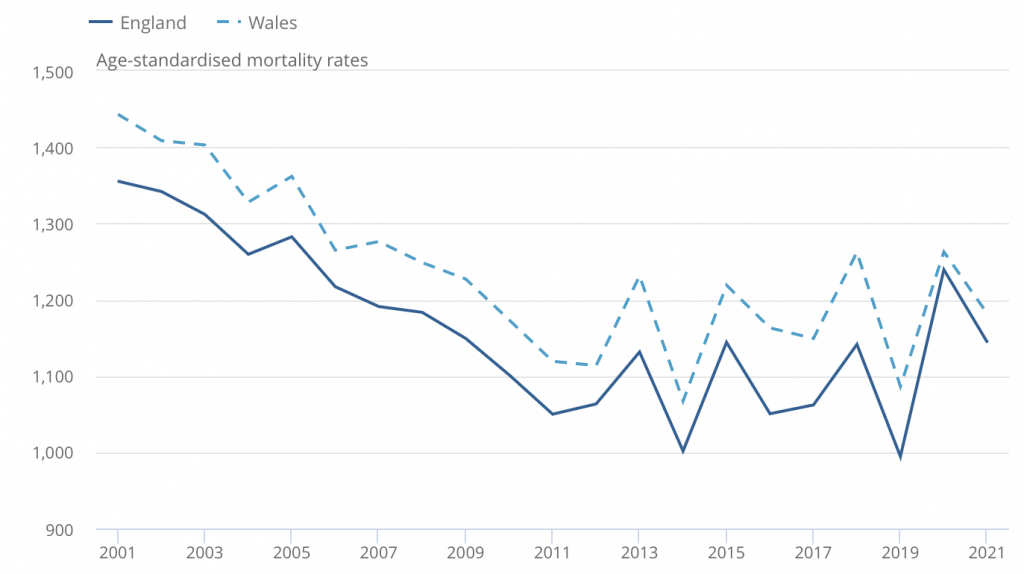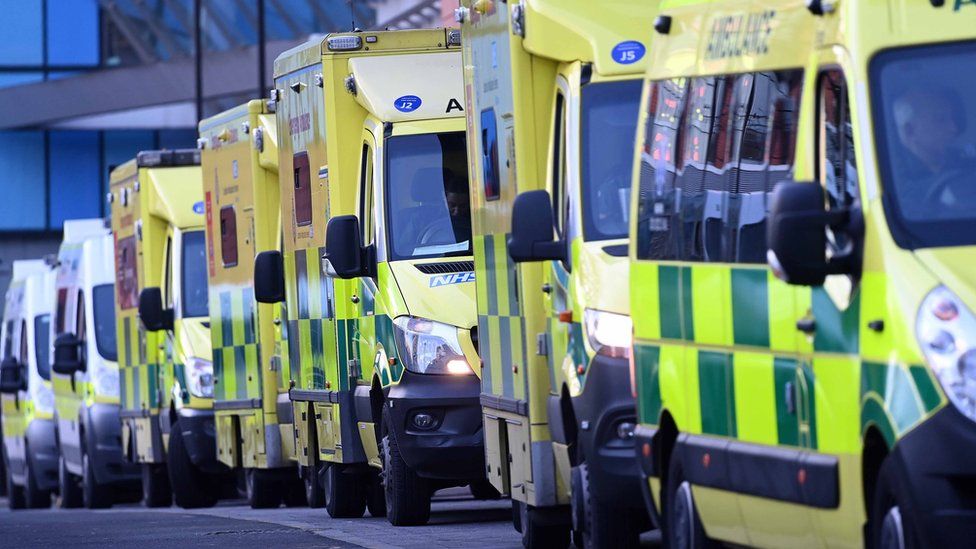The ONS announced today that there were 38,899 deaths registered in England in April, which is 15% less than in March, and 6% less than the five-year average. However, as I’ve noted before, the best overall measure of mortality isn’t the number of deaths, or even the death rate, but rather the age-standardised mortality rate.
In April, the age-standardised mortality rate was 12% lower than in March, and a remarkable 12.5% lower than the five-year average. As a matter of fact, it was the lowest on record for that month. (The ONS’s dataset goes back as far as 2001, and given that mortality has been decreasing more-or-less continuously for the past few decades, April’s age-standardised mortality rate was probably the lowest ever.)
This chart from the ONS shows the age-standardised mortality rate for the first four months of the year, each year, going back to 2001:

Although 2021’s figure was higher than the figure for 2019, it was only 0.2% higher than the figure for 2018, and was actually equal to the figure for 2015. Hence – despite higher-than-expected mortality in January and February – the overall level of mortality in the first four months of the year was close to what you’d expect.
If the age-standardised mortality rate remains low for the next two or three months, it will “cancel out” a large share of the excess mortality observed in the second wave. Indeed, the most plausible explanation for the current low level of mortality is that deaths were “brought forward” by the pandemic.
This post has been updated.












To join in with the discussion please make a donation to The Daily Sceptic.
Profanity and abuse will be removed and may lead to a permanent ban.
Tomorrow’s dry tinder… and reason to lock down again.
And not changing the fact that each NPI and restriction will have had only one, most desired by them, effect: reducing the average life expectancy of the people over time.
And the effect of the big one on that, the gene therapies, is still outstanding and totally up in the air.
The ‘dry tinder’ issue is one of the reasons that I kick against short-term baselines and analysis timescales, because mortality rates work in longer periods than single years.
It’s a massively important analytical issue.
Fon and MTF would disagree……
Yes, mostly some people’s deaths were brought forward first by the virus then by the panic response, then by the “vaccines”.
However this will be interpreted as how well the lockdowns have worked, and of course the success of the vaccines. So I don’t expect anything to change any time soon.
But not outstanding for those it killed, or up in the air for those harmed!
Haven’t we run out of tinder… at least for a year? (with obligatory :-()
Yes, the ‘dry-tinder’ effect is a very common sense way to look at it (sad but true). This was a driving factor in why Sweden started off worse than other Nordic countries. Those countries had had a couple of bad years (elderly deaths) previously and so stocks in ‘the wood shed’ (to continue the analogy) were pretty low compared to Sweden.
Death is the certainty of life.
So the BBC is a shyster organisation. Who knew
https://www.bbc.co.uk/news/uk-57189371
https://www.youtube.com/watch?v=WuSlK-DfUKc
Statement from the BBC regarding Martin Bashir, from Sebastian Fat-Salary, BBC Director of Marxist Cuntwaffle
https://www.bbc.co.uk/news/uk-55518248
wards filling up with covid kids
For those who don’t go to the link and read this story: The wards are NOT filling up with kids suffering from severe COVID. Quite the contrary.
Kudos to this news organization doing some real journalism.
I think the BBC forgot to clarify that Ms Duffel was a labour activist.
If the Diana affair is now an example of the BBC falling below its own high standards ( ha ha, ever so ha), what will be said, twenty years from now, about its abysmal conduct over the Covviebollox?
There is a clear parallel. Both are examples of a media-led mass psychosis.
Today’s BBC home page: mostly ‘pandemic’ scare stories, tawdry ‘entertainment’ titbits, a bit of sport, a couple of recipes. “Indian variant could drive another wave, scientist warns.” Yes, another wave of bollocks and bullshit. “Kane wants ‘honest’ talk about future.” Don’t we all? “Demi Lovato is non-binary and has changed pronouns.” Who is Demi Lovato and why is this news? High standards indeed. It’s sinister and imbecilic all at the same time.
I have never heard of him but I would say that Demi Lovato should be locked away for the sake of society. Sounds a right twit
Indeed, probably another fictional minister 😀
I wish they were f.ing fictional rather than a living (well sort of) nightmare!
Jim Hacker?
Hmm, but when will he be given half a chance to do anything his bosses don’t want?
Ha ha ha ha ha ha ha… etc
Oh FFS let’s have some data literacy rather than a mirror image of Covid zealot illiteracy:
(1) One month’s figures are an irrelevance. Just a passing footnote.
(2) Ditto a 3-5 year moving or static average. Of interest in context – but that’s all.
Postcard from the South Sandwich Islands
Day 14
Been a news blackout for the past four days
Stan got wind from the phone taps of a group of dissident penguins planning a protest
Mrs Dick kindly flew in units of her Territoriale Unterstuzungsgruppe Adolf
Hitler South London
They kicked the shit out of the protesting female penguins which seemed to do the trick
More like the South Sandreich Islands for the last few days
Thanks to the award of an advertising contract the protests were not reported by the Bouvet Broadcasting Corporation
In recent days the BBC have also done some great reports of near death Penguins on ventilators and in hospital corridors
Although they were reported to be scenes from Northern Italy they were actually all filmed on location at Penguin World Florida using out of work Penguin Porn stars
Think the islanders are really starting to warm to me. The press reports describe me as ‘loveable’
I hear that newly laid penguin eggs are now being vaccinated against Penguin Flu. Is there any truth in this statement?
There is truth in any statement if I say it is so
Pingu flu
I like it
The agenda is clear. Jabs every six month or exclusion from society
What they don’t understand is that I don’t want to be part of THEIR society.
I cancelled my membership in March 2020, but they keep sending me reminders
Indeed, the most plausible explanation for the current low level of mortality is that deaths were “brought forward” by the
pandemicvaccination programme.FIFY.
I cant work what is going on here. If we assume that the ONS Statistics are correct, then it seems to indicate that both the government and my own understanding of the world is wrong.
With lower than average deaths, the government cannot claim that there is a pandemic and has no right to restrict anyone’s freedoms. But I need to criticise myself here. There should be lockdown deaths occurring. We know that there are huge waiting lists for life threatening cases, millions of extra people now waiting. We also know that people are dying vaccine deaths. We also know that people cannot get to see a Doctor most of the time, and yet despite all of this, we have lower than expected deaths?
I understand that there is an explanation in that there is a ‘rebound’ as a result of older people previously dying from Covid. I accept that this is partly true, but we know that a lot less people really died of Covid than reported so there wasnt so much to ‘rebound’ from.
So what on earth is really going on? I suppose that one explanation could be that the ONS statistics are just fiddled. But suppose that the figures are good and true, what does that mean?
One explanation is that by avoiding hospital people are living longer. That would be a remarkable fact if it is the explanation.
Another explanation is that lockdown isnt costing lives at all, but is extending them. I dont know why that would be, but it could be an explanation. Odd though with these two effects is that they have only kicked in for the last few months.
Can anyone else come up with an explanation as to why there are less deaths than expected.
Meanwhile, there is a great great interview with Nina, a receptionist at a practice, talking to James Delingpole on the Delingpod. Listening to it I wonder how the death figures can be so with this report telling us of ‘thousands’ of vaccine injuries at a practice of 20 – 30k.
I had the same thought on the interview with Nina. She referenced 20k patients and “hundreds” of women reporting menstrual issues. Presumably the practice has 10k female patients, and the number of post menopausal women in their 50s who would report bleeding would be at most 2k, if demographic spread is normal. And only 90pct of those at most vaccinated, again if normal uptake. So it seems high.
“Hundreds” would suggest at least 200, which would be around 10pct or more. Which seems like we would have heard more about it? Maybe she’s prone to hyperbole and isn’t great at estimating numbers
On your other Q on deaths, just because the earlier people didn’t die of COVID, doesn’t mean there wasn’t a high degree of excess death to rebound from. All those old people kicked out into care homes will have had their deaths accelerated- whether they died from COVID or from neglect and trauma from the weird dystopian world they went back into. Especially if they already had dementia…and we did see dementia and cardiovascular deaths plummet in Spring 2020 (largely reclassified as COVID, but whatever they died of, it was lockdown related).
On the other hand, fewer medical interventions will lead to fewer near term deaths (fewer medical cock ups), but more longer term death and disability as conditions remain untreated. So I think we are yet to see the wave of death from lockdown related denial of medical treatment.
Maybe there are a lot of deaths which haven’t been reported, either because the family don’t want the expirant to risk going to a mortuary in case they catch Covid or because they are waiting for a lifting of lockdon so that all th family can attend the wake and not just the favoured 30.
Perhaps there will be a sudden upsurge in reported deaths come June 21st (or whatever subsequent date Bozo decides on).
The Treasury and various pension schemes will be interested in that. All the more so due to the economic damage made worse by ‘lockdown’. It’s entirely possible that the Chancellor will join the ‘circular argument’ club to justify delaying the age for state pensioners to avoid paying too much.
In other words, COVID expedited the passing of the very frail and elderly.
Very important to look at the figures in historical perspective. Here are the figures from 1942 to 2020 for England and Wales.
All done in order to set the stage for disease and depopulation in the years to come. To prime citizens to expect a gene therapy jab each year and then full population control. How very naive and indeed stupid so many are.
“Age-Standardised Mortality Rate Falls To Lowest Level on Record “
“In April, the age-standardised mortality rate was 12% lower than in March…”
So… Perpetual Lockdowns clearly work then!
We can exist without any deaths whatsoever if only we stay locked down hard enough and long enough.
Careful what you publish LS. I’m sure Ferguson and his cabal will use this to create another ‘Model‘ to prove that over a period of x months we can indeed achieve zero death rate. A death-free society. Bojo and his circus will be all over that like a rash, the MSM will be at a loss what to tell people…what no holocaust anywhere in the world today? Worst of all, the vast majority, the DD’s, will comply with whatever is needed to achieve it and ferociously attack anyone who questions the ‘logic’.
LS, please stop encouraging them It’s not good for them!.
Yep. It couldn’t possibly be anything to do with herd immunity so it must mean that face rags work and we must all keep wearing them.
I ask you if you’ve time to listen to or watch any of the interviews I’ve given in the last few weeks.
It’s taken me longer than it should have to appreciate that there isn’t just the odd mismatch of what Govt & their advisors say and the reality, but that literally EVERYTHING we’re told is a lie.
Specifically, every one of the main narrative points around this virus is a lie.
Further, that all round the world, the same “mistakes” were made & continue to be made, in the face of increasing evidence contradicting the official narrative.
That’s either the mother of all Coincidence Theories or it’s evidence at least of international coordination. It’s cannot all be follow the leader because in many cases, the lies were brought in close in time.